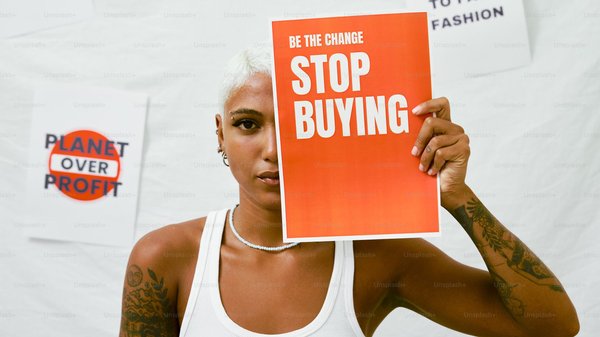Strategist’s Digest: April 2020 /
Contagious digests the most interesting and relevant research from the world of advertising and beyond, because there’s just too much to read and too little time.
James Swift
/
In this month’s Strategist’s Digest:
1) Why brand activism might be a losing game
2) Why creative ideas get rejected
3) The link between the happiness of a country and its ad spend
4) Why sexual ads trigger financial impatience in men but not women

Brand activism: Does courting controversy help or hurt a brand? /
By Sourjo Mukherjee, Audencia Business School; Niek Althuizen, ESSEC Business School
Give it to me in one sentence.
Brand activism doesn’t impress people who agree with the stance, but it puts off those that don’t.
Give me a little more detail.
The researchers conducted five experiments into how people’s attitudes towards stationery, food and soft drink brands changed after reading the companies had taken a position on immigration, abortion and freedom of speech.
They found it had an asymmetric effect, producing almost no change in people who agreed with the stance and angering those that didn’t. The latter camp also changed their behaviour, rejecting freebies and turning down the opportunity to make a little money by promoting the brand on social media.
But backlash changed the asymmetric dynamic: when a brand came under attack for supporting a cause, people who agreed with the stance rallied behind it, but only a little.
Why is this interesting?
Politics and lifestyle have merged and social issues are a regular feature of public, mainstream discourse. Whether they enter into these discussions deliberately or find themselves caught in cultural crossfire, brands need to learn how to navigate social issues. Too often, their strategy is based on idyllic thinking.
Any weaknesses?
The authors themselves point out that this study only tests the effect of one-off statements from brands, adding that ‘regularly engaging with controversial issues in an ideologically consistent way may strengthen the distinctiveness and coherence of a brand's identity’.
Where can I find the whole report?
Here, if you’re willing to pay.

Photo by Steve Johnson on Unsplash
Why Do Great Creative Ideas Get Rejected? The Effect of Creative Ideation Processes On External Judges' Assessments /
By Mark Kilgour, University of Waikato; Scott Koslow, Macquarie University; Huw O’Connor, University of Waikato
Give it to me in one sentence.
The more original a creative idea, the less likely it is to be judged appropriate to the brief.
Give me a little more detail.
The researchers created an experiment with two US agencies. They asked creatives and account execs to make ads for an insecticide, rate their ideas’ originality and appropriateness (to the brief), and then try to sell their best idea by explaining it in writing. The researchers then asked grad students matching the target market of the ads to judge the ads according to a thorough set of criteria.
As the researchers hypothesised would happen, creators and judges rated the originality of ideas similarly. But they diverged when it came to judging appropriateness (the creators usually thought their ideas were appropriate; the judges disagreed). And the most original ideas often got the lowest scores for appropriateness.
But the researchers also discovered that expression quality (how well creators could explain and sell their ideas) made a significant difference to judges accepting them as appropriate.
Why is this interesting?
The researchers posit why creators and judges struggle to agree on the appropriateness of ideas. If a creative comes up with something new by connecting existing bits of knowledge, ‘the resulting moment of insight reshapes his or her memory categories’. The people judging the work haven’t gone through that mental process, and so they struggle to make the same links.
The findings on expression quality also, according to the researchers, embody ‘the crux of a debate over whether creativity is a personal or social endeavor’, and they argue that ‘Creative ideas do not stand for themselves.’
Any weaknesses?
Using students (however well briefed) as judges doesn’t really reflect the reality of early-stage creative evaluation in advertising. Also, and it’s not really a weakness, but many of the findings here are probably intuitively known by agency workers. Still, that’s not to dismiss the value of having them tested so thoroughly.
Where can I find the whole report?
Here, if you wish to pay.

Photo by Andre Hunter on Unsplash
Advertising as a Major Source of Human Dissatisfaction: Cross-National Evidence on One Million Europeans /
By Chloe Michela, Swiss Re; Michelle Sovinsky, University of Mannheim; Eugenio Proto, University of Glasgow; Andrew J. Oswald, Warwick University
Give it to me in one sentence.
Countries with more advertising have less happy citizens.
Give me a little more detail.
Researchers took life satisfaction data from 27 European countries between 1980 and 2011 and matched it with corresponding ad spend data. They found an inverse correlation: the higher the ad spend in the country, the less satisfied its citizens.
‘Our analysis shows that if you doubled advertising spending, it would result in a 3% drop in life satisfaction,’ Oswold told Harvard Business Review, which picked up the research more than six months after it was publishing, renewing interest in the work.
Why is this interesting?
This is admittedly a controversial inclusion for the Strategist’s Digest, but it doesn’t behoove the industry to ignore research like this when it comes along, because advertising’s critics sure won’t.
And anything that increases marketers’ understanding of how their output is perceived and received can only lead to better work, as far as we’re concerned.
Any weaknesses?
The researchers were thorough and controlled for many other influences, but even they admit that ‘strict causal interpretations’ of the correlation they discovered ‘are not possible’.
Where can I find the whole report?
Here, and it’s free. But the Harvard Business Review article is easier to read.

Sexually Arousing Ads Induce Sex-Specific Financial Decisions in Hungry Individuals /
By Tobias Otterbring, Aarhus University; Yael Sel, University of Michigan
Give it to me in one sentence.
Sexual ads induce hungry men to make impatient financial decisions, but they have the opposite effect on hungry women.
Give me a little more detail.
The researchers divided 265 university students into three groups: one was shown sexual ads, another was shown non-sexual ads, and the third was shown no ads at all. The participants (who rated their own hunger levels) were then asked to choose: they could either receive $30 tomorrow or $35 in 20 days time.
The study showed that hungry men exposed to sexual ads were more likely to exhibit impatience with regards to the financial reward. Hungry women on the other hand were more likely to wait for the bigger score. There was no difference in behaviour between men and women when their bellies were full.
Why is this interesting?
Honestly, we just thought this month’s Strategist’s Digest could use a little levity. That said, the researchers attribute their findings to the parental investment theory, which is interesting.
They write: ‘In ancestral times, it should have been more harmful for women to engage in uncommitted sex when the availability of nutritious foods was scarce, given the vast metabolic costs associated with a pregnancy. Conversely, resource scarcity has been shown to trigger more shortsighted behaviors in men, presumably in a response designed to increase the chances of passing their genes on before it is too late.’
Any weaknesses?
It’s probably not going to come up at your next strategy meeting.
Where can I find the whole report?
Here, and it’s free. But if you don’t have the patience for that (perhaps because you’re a hungry, horny man) there’s a report in Psypost that’s even shorter.
Like the way we think? This is just a taste of the kind of information that’s available to our members. Find out more about Contagious membership, here.
Want more of the same? /
We don’t just write about best-in-class campaigns, interviews and trends. Our Members also receive access to briefings, online training, webinars, live events and much more.






